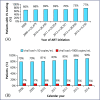The challenges of ending AIDS in Asia: outcomes of the Thai National AIDS Universal Coverage Programme, 2000-2014
- PMID: 29057081
- PMCID: PMC5632544
- DOI: 10.1016/S2055-6640(20)30323-X
The challenges of ending AIDS in Asia: outcomes of the Thai National AIDS Universal Coverage Programme, 2000-2014
Abstract
Objectives: We sought to determine Thai National AIDS Program (NAP) outcomes and gaps, and success in reaching the WHO 90:90:90 goals.
Methods: Retrospective study of treatment outcomes, mortality and loss to follow-up (LTFU), of all individuals aged >15 years who registered to the NAP from 2000 to 2014. We focused outcomes on data from 2008 when the NAP was linked to the death registry.
Results: A total of 429,294 patients registered to the NAP up to November 2014, and 309,313 patients aged >15 years started ART. Median (IQR) age was 37 (31-43) years; 51% were male. From 2008 to 2014, long-term follow-up rates per 100 person-years were 3.2 in those who started ART vs 3.5 in those who did not (P<0.001) and mortality rates per 100 person-years were 3.5 in those who started ART vs 4.9 in those who did not (P<0.001). Mortality reduced from 16% in 2008 to 3% in 2014 for those who started ART. For patients starting treatment since 2000, 87% of those alive and with a recent viral load (VL) result had <50 copies/mL, and 6% had VL ≥1000 copies/mL. In a continuum-of-care analysis from 2008 to 2014, 68% were living and retained on ART, and 46% of diagnosed individuals were virally suppressed at <50 copies/mL.
Conclusions: In the Thai NAP, death and LTFU are major factors disrupting the care-continuum, and many patients initiate ART with low CD4 cell counts. Rolling out systems for early detection and treatment for all, regardless of CD4 cell count, are essential and under way.
Keywords: HIV, treatment outcomes, Thailand, universal health coverage.
Figures




References
-
- Thai National AIDS Committee Thailand AIDS Response Progress Report. Thailand: 2015. Available at: www.unaids.org/sites/default/files/country/documents/THA_narrative_repor... ( accessed September 2017).
-
- Chasombat S, Lertpiriyasuwat C, Thanprasertsuk S et al. . The national access to antiretroviral program for PHA (NAPHA) in Thailand. Southeast Asian J Trop Med Public Health 2006; 37: 704– 715. - PubMed
-
- Chasombat S, McConnell MS, Siangphoe U et al. . National expansion of antiretroviral treatment in Thailand, 2000–2007: program scale-up and patient outcomes. J Acquir Immune Defic Syndr 2009; 50: 506– 512. - PubMed
Publication types
LinkOut - more resources
Full Text Sources
Research Materials
